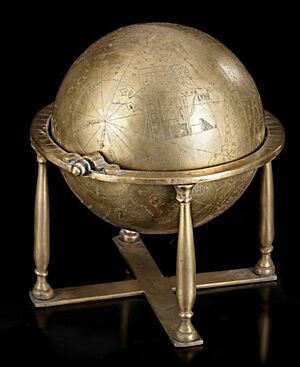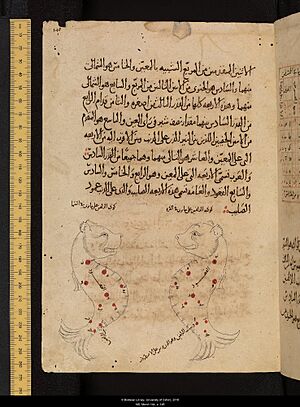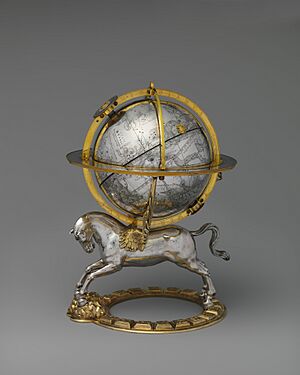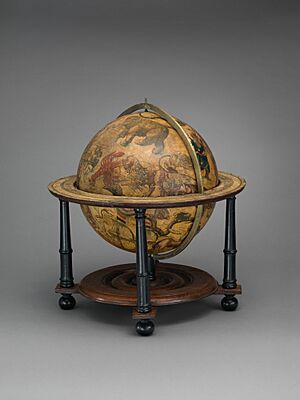Celestial globe facts for kids

Celestial globes are like maps of the sky, shaped like a ball. They show where the stars appear to be in the sky. These globes usually don't show the Sun, Moon, or planets because their positions change all the time compared to the stars. However, they do show the ecliptic, which is the path the Sun seems to follow across the sky.
One interesting thing about celestial globes is how the stars are shown. When you look at the real sky from Earth, it's like you're inside a giant sphere looking out. But a celestial globe shows the stars on its outside surface. This can make the star patterns, called constellations, look like mirror images of what you see in the actual sky. To fix this, some globes are made so the constellations look correct when you view them.
Some newer celestial globes are made from clear, see-through material. This way, the stars can be placed in their correct spots, and you can look through the globe to see them, almost like you're inside the sky. Another trick is to look at a regular globe in a mirror. If the globe's writing is printed backward, it will look normal in the mirror, and the constellations will appear as you know them.
For a long time, people believed that Earth was the center of the universe and that the stars and planets moved around it. This idea is called the Geocentric model. In the 1500s, a scientist named Nicolaus Copernicus discovered that the Earth actually orbits the Sun. This is called Heliocentrism. Even before this discovery, astronomers used celestial globes to show how they thought the stars were arranged and moved around Earth.
Contents
History of Celestial Globes
Early Globes
The Roman writer Cicero mentioned that the first globe might have been made by Thales of Miletus in ancient Greece. This suggests that celestial globes could have existed a very long time ago, but we don't have any surviving ones from that period.
The Greek astronomer Ptolemy, who lived in the 2nd century AD, wrote about how to design and make a celestial globe. He even suggested coloring the globe a dark color to look like the night sky.
The Farnese Atlas is a famous Roman statue from the 2nd century AD. It shows the mythical figure Atlas holding a large celestial globe. This globe doesn't have stars drawn on it, but it shows more than 40 ancient Greek constellations in great detail. For many years, this was the only known ancient celestial globe. Later, two smaller ancient globes were found: one made of brass and another of silver.
Al-Sufi's Star Book

Abd al-Rahman al-Sufi was an important astronomer in the 900s. His book, The Book of Fixed Stars, was very important for making celestial globes in the Islamic world. It described constellations by combining Greek and Arabic traditions. This book helped astronomers across the Islamic world get accurate star positions for making globes and other tools like astrolabes.
11th Century Globes
The oldest celestial globe that we still have today was made between 1080 and 1085 by Ibrahim ibn Said al-Sahli in Valencia, Spain. This globe shows all 48 of the classical Greek constellations, with circles marking the stars, similar to what Al-Sufi described in his book.
13th Century Globes
In the 1200s, a celestial globe was made at a famous observatory in Maragheh, Iran. This globe, now in a museum in Dresden, Germany, was created by Muhammad b. Mu'ayyad al-'Urdl in 1288. It shows how both science and art came together in making these tools.
This globe has all 48 classical constellations from Ptolemy's work. This meant it could be used for many things, like figuring out directions, keeping time, or even creating horoscopes. The globe is also a beautiful example of art from that time, with detailed engraved figures on its brass surface.
17th Century Globes

In the 1600s, many celestial globes were made. One famous example was created by Diya’ ad-din Muhammad in Lahore (which is now in Pakistan) in 1668. This globe is now kept at the National Museum of Scotland. It has rings around it that help show different parts of the sky.
The workshop in Lahore that made this globe was very famous, producing many globes. This particular globe was made in one seamless piece. It also has grooves that divide its surface into 12 sections. These sections helped astronomers find the positions of stars and were linked to the 12 houses of the zodiac.
See also
- Armillary sphere
- Celestial sphere
- De sphaera mundi



